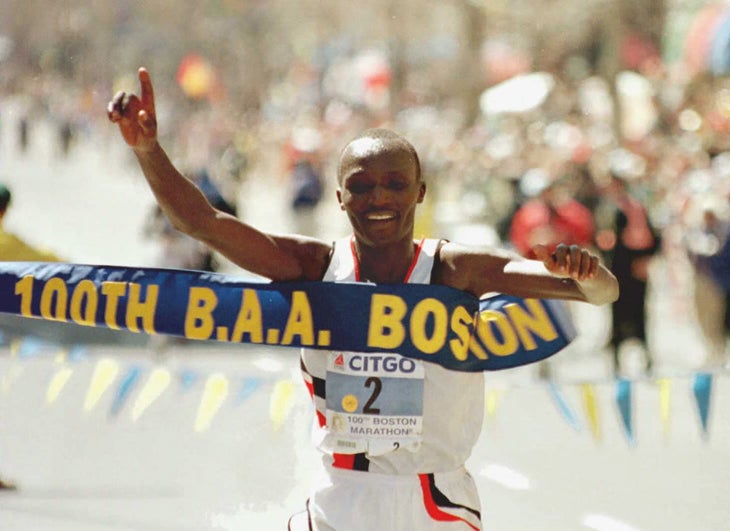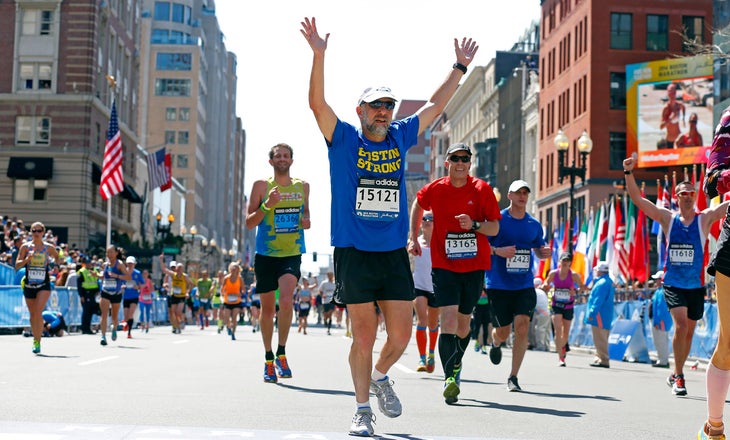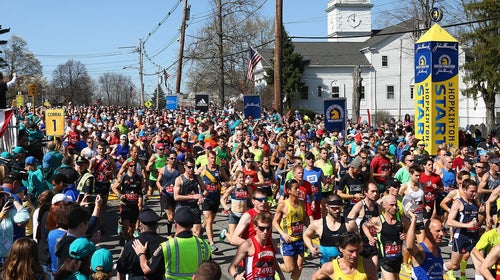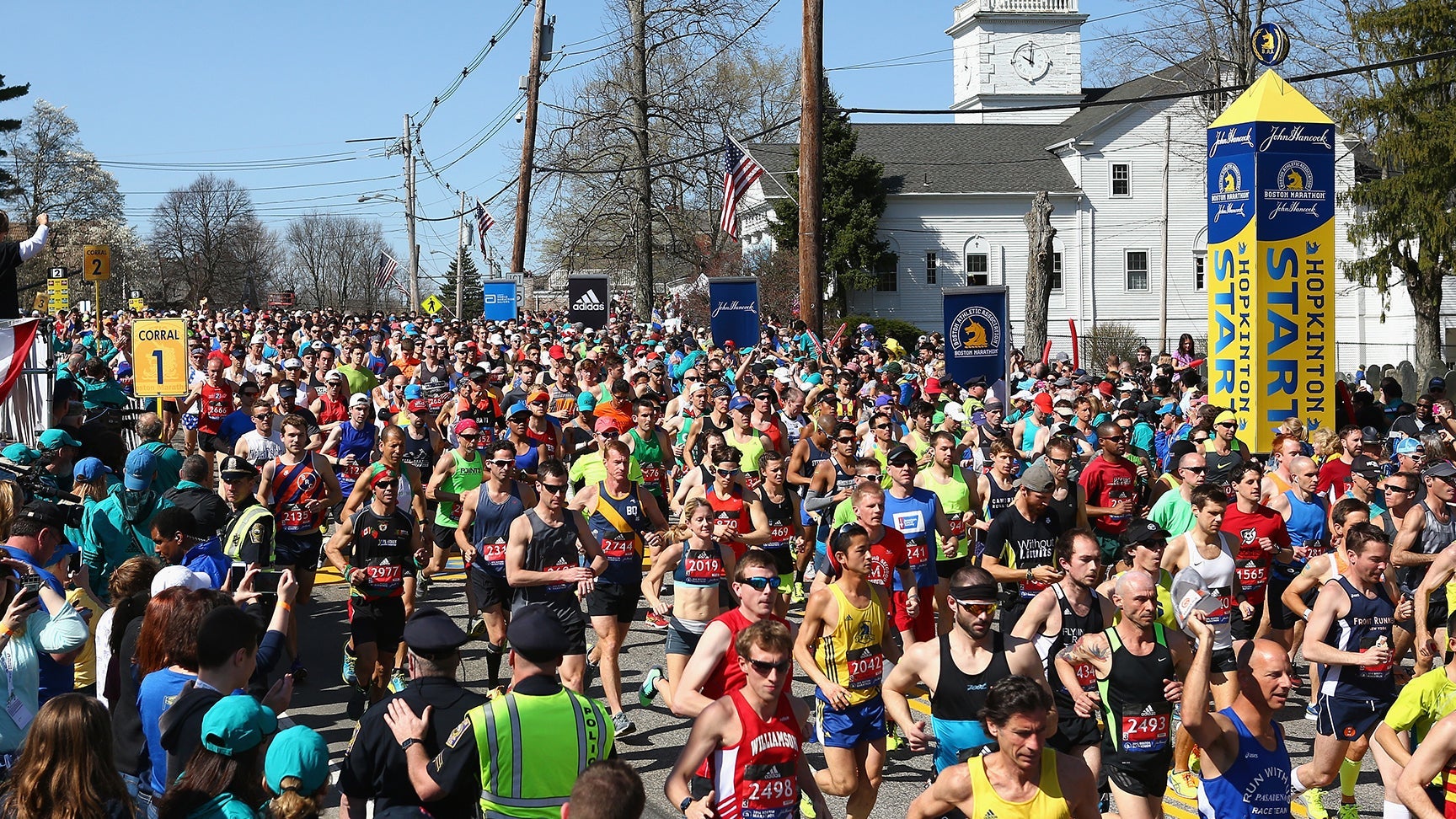For marathoners, every Boston is special. But the 125th Boston Marathon that will be run on Monday, October 11, is destined to be among the top three historically significant races in the event’s long history. Boston in the fall will take its place alongside the 100th Boston in 1996, and Boston Strong, the post-bombings running in 2014. All three are characterized by a potent brew of nervous uncertainty and wild celebration.
Boston in October
Monday, October 11, 2021
Monday’s race will be the first Boston held in the autumn, due of course to COVID-19 cancellations the past two Aprils. Prior to 2020, the Boston Marathon had been run continuously every April since 1897, although the 1918 race consisted only of a military relay over the course.
October, obviously, has many differences from April. “This will be the first Boston where runners won’t see forsythia or blooming daffodils,” notes Tom Derderian, Boston historian and book author. “Instead they should be greeted by colorful leaves in the trees, and perhaps some shade on the road.”
A COVID-influenced Boston Marathon in October means that the field size has been reduced by about 30 percent to 20,000 starters. Another way of putting it: Ten thousand runners who thought they had a great chance to qualify for Boston this year found out to their disappointment that quite the opposite was true. Of course, it’s hard to complain when race organizers are trying to limit a pandemic’s spread.
The 20,000 runners still headed to Boston will have to produce a vaccination card or pass an onsite COVID-19 test. As a result, the marathon has an unexpected new partner: Quest, the medical diagnostics company.
Boston will have its usual world-class field, including a number of former winners. But, frankly, at all the big fall marathons, the return to mass participation is a bigger story than the racing.
On Monday morning, only the elite races — female and male, wheelchair and open — will start in the usual simultaneous “go” manner. No one else will be placed into waves or corrals. Instead, after their buses reach Hopkinton, runners can visit porta-potties, get a bit of fluid, and stroll the curving three-quarters of a mile to the start beside the Town Green. When you get to the line, you’re good to go. It’s called a “rolling start,” and the computer timing chips are in charge.
The second Monday in October is Indigenous Peoples’ Day — quite different from Patriots Day in April. After protests from Indigenous groups on the course, the Boston Athletic Association apologized for overlooking and overshadowing the Indigenous Peoples’ Day events, and will honor the day in several ways, including a land acknowledgment ceremony before the start, and recognizing current and historic indigenous Boston marathoners. The Marathon will honor the memory and family of “Tarzan Brown” of Rhode Island’s Narragansett tribe and a two-time Boston winner (1936 and 1939). And well-known New England runner Patti Catalano Dillon, a three-time Boston runner up and member of the Mi’kmaq nation, will take part in the ceremonies.
The Red Sox always play on Marathon day, but usually, it’s just a meaningless early-season game in April. October brings World Series fever, and the Sox are on the cusp. Sunday afternoon, October 10, they’ll play the Tampa Bay Buccaneers in the American League Divisional Series. It’s a 3 out of 5 playoff, and if neither team sweeps the first three games, there will be another one Monday evening just a few hours after the late Marathon finishers straggle past Fenway.
There’s an Expo but it seems unlikely runners will tarry for long. Also, no clinics or indoor talks. Instead, race organizers have put together an outdoor Boston Marathon Fan Fest by Amazon that will take place all weekend long, beginning with “Opening Ceremonies” Friday night at 6 p.m.
“Our runners have been waiting for more than 900 days to return to Boston, and we couldn’t be more excited to welcome them with open arms,” says Tom Grilk, President and C.E.O. of the Boston Athletic Association. “The 125th Boston Marathon won’t be just a milestone athletic event. It’ll be a symbolic race marking the continued re-opening of society, safely bringing people together to celebrate the triumph and spirit of the marathon.”
Expected Starters: About 20,000
Winners of last in-person Boston, 2019: Lawrence Cherono, 2:07:57; Worknesh Degefa, 2:23:31
Course Records: Geoffrey Mutai, 2:03:02, 2011; Buzunesh Deba, 2:19:59, 2014
The 2021 Marathon Program is available online.

The 100th Boston Marathon
Monday, April 15, 1996
Before 1996, the largest Boston Marathon starting field was the 9629 runners who assembled in 1992.
Boston organizers figured more would come for the Centennial, imagining they might see another 10,000. Whew, bad guess. Neither the BAA nor anyone else foresaw what a country full of determined runners could do with a lot of motivation and a year of training.
Everyone knew the 100th Boston would be the greatest marathon in history, and everyone wanted to be a part of it. When the dust and blood and sweat and tears and blisters had settled, more than 38,000 runners squeezed into tiny Hopkinton, with a population then of about 12,000.
Next question: How the heck is this going to work? Runners and journalists alike predicted a logistical disaster. What if the buses got gridlocked on the Mass Pike? What if the runners broke into fisticuffs over a frustratingly slow trek up Main Street to the start line? What if the new-fangled timing chips, a recent road-race innovation, failed to function properly?
Things could definitely have turned sour. Take the weather. In the week prior to the Marathon, 18 inches of wet snow fell, turning Hopkinton High School’s athletic fields (“The Athlete’s Village”) into a gloppy, muddy mess of Woodstock proportions. The day after the Marathon brought torrential rains.
But Monday, April 15, was perfect in every way. Perfect. In every way. The weather: crystal clear, sunny, 55 degrees, great for runners and spectators alike.
And you’ve never seen a better-behaved throng of marathoners. Everyone got the message. This isn’t a competition, folks, it’s a celebration. The journey — the qualifying — yes, that took the best you could give, and then some. But the running itself, that’s pure frosting on the cake.
We didn’t have cell phone cameras in 1996, but remember those disposable cardboard box cameras? We ran with our pockets and hip packs stuffed full of them, wanting to record every scene on that memorable day.
How often do you get to run a Centennial race? Exactly once. So you’d better make the best of it, and come home with as many keepsake photos as possible.
On the elite front, Kenya’s Moses Tanui ended the threepeat streak of his countryman Cosmas Ndeti, while Uta Pippig came from behind to pass Tegla Loroupe in the final miles, notching her third consecutive win.
But mostly, people remembered that the seemingly impossible had proved possible. “The 100th Boston put a small city of runners in a village where once ran only a handful of skinny young men,” notes Derderian. “And masterful logistics proved that such an undertaking could be successful.”
Adds renowned running author Hal Higdon: “Other than the original marathon in Athens in 1896, it was the most important race our sport has ever seen. And it succeeded on such a large scale that it produced an epic change in marathons going forward.”
Starters: 38,708 (previous high, 9629, in1992)
Winners: Moses Tanui, 2:09:15; Uta Pippig, 2:27:12

Boston Strong, Boston Forever
Monday, April 21, 2014
For a day or two after the finish line explosions of 2013, the shock and grief felt excruciating. Marathon runners and media wondered if the sport could survive: Why would anyone run a race on open streets, exposing themselves to potential threats from all sides? (Important note: The Boston bombs were not directed at runners but at local citizens enjoying a public holiday in a public space.)
Then the tide turned. Dramatically. The words “Boston Strong” became a national and international rallying cry. Runners took up the theme in their unique way, vowing not to shrivel and shrink from the Boston Marathon but to return and reclaim it in 2014. It was, after all, the shining, historic symbol of their sport.
Once again, as in 1996, Marathon organizers found themselves nearly overwhelmed by the demand for spots in their race. Once again, they bent as far as could while striving for runner and spectator safety.
This time we were nearly 36,000 strong in Hopkinton. I had been fortunate enough to run in 1996, and I managed the trick again in 2014. Afterwards, I was forced to amend an oft-repeated claim. For years after the Centennial, I had told anyone who would listen that it was the greatest marathon ever, and likely to remain so for a very long time.
Nope. I was wrong. The 2014 Boston was not bigger than 1996 nor was it necessarily “better.” But I’m absolutely certain it was the most emotional marathon of all time. And what is a marathon, in the end, but an emotional encounter with the distance and yourself?
We may chatter endlessly about legs and lungs and cardiac capacity, but we run marathons with and in our heads. We experience marathons through all our senses — sound, sights, smells, tastes, and more. Something is surely going on outside us. Yet what goes on inside, the way we process these senses, is ever so much more important.
Many of the 2014 runners held signs reading, “We love you Boston.” The spectators, in turn, raised signs saying, “We love you runners.” They were also, by the way, far more numerous and louder and encouraging than any other year.
It was a lovefest, no other name for it. If you were there, you know what I mean. If you weren’t, I’m sorry. Running the 2014 Boston Marathon was the greatest privilege of my long running career.
Everyone felt the force, and none more so than Meb Keflezighi. Though not considered among the top-10 favorites, Meb broke the race wide open midway — What, are you crazy, man? That’s no way to compete over 26 miles — and saved enough for a finish sprint to become the first American winner since Greg Meyer in 1983.
Which it turns out is only half the story. The other half: In the four corners of his race bib, Meb had hand-scrawled the names of the previous year’s four bombing victims.
“I just told myself, ‘This is Boston Strong,’ Kefleghizi said later. “I wrote their names big so I could get their strength. To have that inner motivation was huge.”
Yes, indeed. The marathon. It comes from within. And the 2014 Boston was one for the ages.
Starters: 35,671
Winners: Meb Keflezighi, 2:08:37; Buzunesh Deba, 2:19:59


